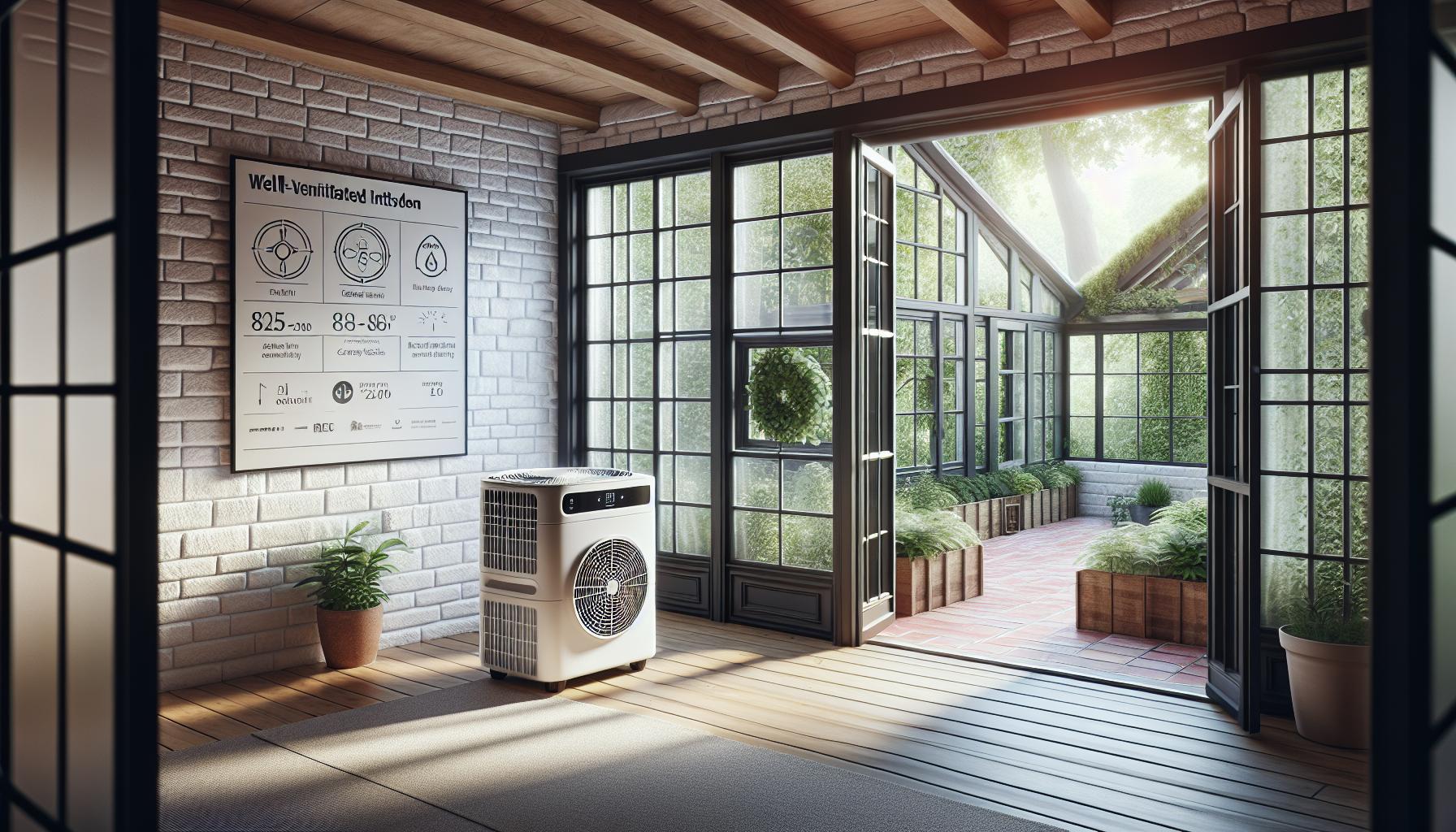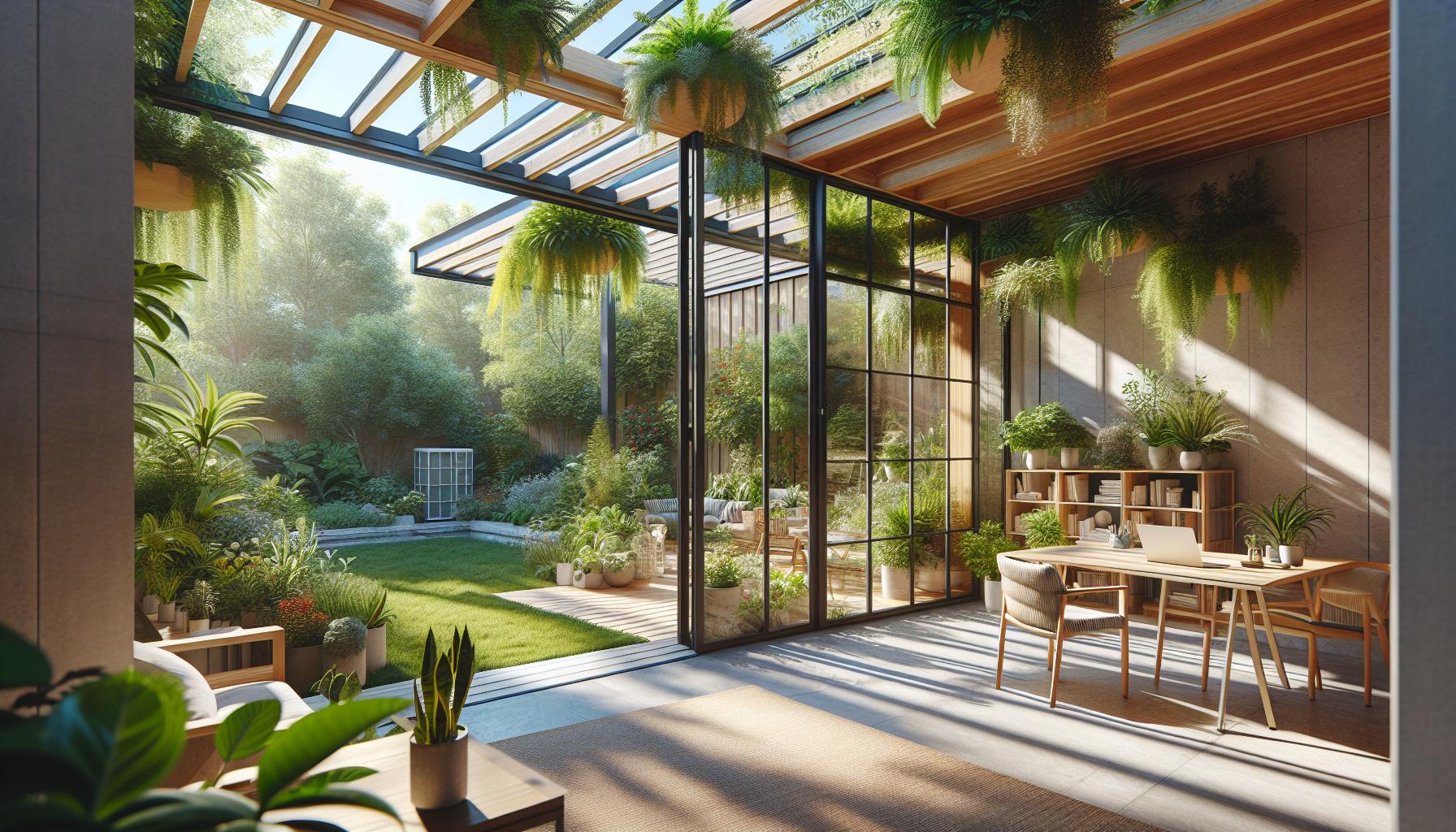Does a Garden Room Need Ventilation? Essential Tips & Misconceptions
Ever thought about adding a garden room to your space? Whether it's for a cosy studio, a sleek office, or your own private gym, garden rooms are the ultimate flex in home improvement. But here's a question you might not have pondered yet: does a garden room need ventilation? It's a topic that's not only intriguing but essential for ensuring your garden room is comfortable, safe, and durable.
Ventilation in a garden room isn't just about keeping the air fresh. It's about controlling humidity, preventing condensation, and ensuring a healthy environment for whatever you're planning to use the space for. Let's jump into why ventilation should be high on your priority list when planning your garden room. Trust us, it's a game-changer.
The Importance of Ventilation in a Garden Room
When you're diving into the world of garden offices, gyms, or studios, understanding the role of ventilation can really be a game-changer. It's one of those things that might not seem glamorous or exciting but think of it as the unsung hero that keeps your garden building comfortable, fresh, and most importantly, healthy.
Why Ventilation Matters
Imagine your garden room as a living, breathing space. Just like you, it needs a good flow of air to stay in tip-top condition. Without proper ventilation, the air becomes stale; moisture levels rise, leading to condensation and potential mold issues. It's not just about comfort; it's about protecting your investment and health.
Common Misconceptions
Many folks think cracking open a window now and then is enough. While it's a good start, it's not the full solution. Consistent, controlled ventilation is key. Don't fall into the trap of thinking ventilation is just for the warmer months. Winter needs it just as much, if not more, to manage indoor humidity levels that can skyrocket with heating and less natural air movement.
Tips and Techniques
Cross Ventilation: Ideally, your garden room should have openings on opposite sides. This setup allows air to flow in one side and out the other, creating a natural breeze that keeps air fresh.
Mechanical Ventilation: For those times when natural ventilation just isn't enough, considering a mechanical system can be a lifesaver. They're especially useful in tightly sealed spaces, where natural airflow is limited.
Roof Vents: Heat rises, so adding a vent at the highest point can help exhaust that warm, moist air that accumulates up top. It's a natural-led way to enhance your room's ventilation.
Incorporating Ventilation into Your Garden Room
Planning is crucial. If you're in the design phase, talk to your designer or contractor about incorporating integrated ventilation solutions. If your garden room is already standing, there are still plenty of ways to improve airflow. Start with assessing your current setup and consider the tips mentioned. Sometimes, simple adjustments can have a significant impact.
Controlling Humidity and Preventing Condensation

When you're investing time and money into a garden room, whether it's for a cozy home office, a dynamic gym, or an inspiring studio, understanding how to manage humidity and fend off condensation is crucial. Much like keeping a plant thriving requires the right balance of light, water, and nutrients, maintaining a comfortable atmosphere in your garden room hinges on controlling moisture levels.
Humidity—that invisible water vapour in the air—can be a sneakier guest than you might expect. When it overstays its welcome, it invites a host of issues, from uncomfortable stuffiness to damaging mould growth. Condensation, on the other hand, plays out like that annoying condensation on your cold glass on a hot day, but inside your windows or on your walls, where it can soak into materials and cause damage over time.
First off, common misconceptions often trick people into thinking that a bit of airflow now and then keeps moisture problems at bay. But, consistent and controlled ventilation strategies are key. Don't just fling open a window and call it a day; integrate deliberate ventilation methods into your garden room's design, like cross ventilation, to promote a steady flow of fresh air.
Here's a practical tip: use dehumidifiers or moisture absorbers for an extra punch against humidity, especially in the tighter, more enclosed spaces that don't allow for much airflow. It's like having a sponge that soaks up the excess moisture in the air, keeping things dry and comfortable.
Smart insulation also plays a lead role. Properly insulating your garden room ensures that the inside temperature remains constant, reducing the likelihood of warm, moist air hitting cool surfaces to create condensation. Think of it as wrapping your garden room in a cosy blanket that keeps the warmth in and the chill out, preventing those cold surfaces from becoming a canvas for condensation.
For those looking to tackle humidity and condensation head-on, remember:
Ventilate regularly to maintain a fresh air flow
Use humidity-reducing tools like dehumidifiers
Ensure adequate insulation to maintain stable temperatures
Applying these strategies from the start can make a significant difference in your garden room's climate control, contributing to a healthier, more enjoyable space.
Ensuring a Healthy Environment for Your Garden Room

Creating a healthy environment for your garden room is like ensuring your favourite plant has the right conditions to thrive—it’s all about balance. Ventilation, a key component often overlooked, plays a monumental role in maintaining this balance. Imagine your garden room as a living, breathing space; it needs fresh air to stay vibrant and fresh.
Common Misconceptions and Errors
A common mistake is thinking that an occasional opening of a window suffices for proper ventilation. This is akin to believing a plant can survive on irregular watering. Just as a plant needs consistent care, your garden room requires continuous airflow to prevent issues such as dampness and mould which are not only harmful to the structure but your health as well.
Practical Tips and Techniques
Incorporating cross ventilation is akin to setting up a breeze to flow through a garden. Placing windows or vents on opposite walls allows air to pass through, creating a fresh atmosphere. For more advanced setups, mechanical ventilation systems can be installed, acting as an automated system to keep the air moving, much like a timed watering system for a garden.
Dealing with Humidity and Condensation
In climates prone to humidity, dehumidifiers and moisture absorbers become invaluable tools in your arsenal, similar to using the right soil mix to prevent overwatering. Combining these tools with proper insulation ensures that the internal temperature and moisture levels remain stable, mitigating the risk of condensation - which can be detrimental to both the structure and its contents.
Incorporating Ventilation into Design
When you're in the planning stages, thinking about ventilation as part of the design rather than an afterthought can save you a lot of hassle later on. Consider the placement of windows, doors, and possibly even roof vents to help natural airflow. It's much like planning a garden layout to ensure every plant gets enough sunlight; positioning is key.
By understanding these principles and integrating them into your garden room setup, you're not just building a space; you're cultivating an environment. This ensures that your garden office, gym, or studio remains a healthy, inviting space year-round. Just remember, every space is unique, so what works for one garden room might need tweaking for another. Keep experimenting till you find that perfect balance.
Factors to Consider When Planning Ventilation for Your Garden Room
Ventilating your garden room, whether it's a cozy office space, a dynamic gym, or an inspiring art studio, isn't just about opening a window or installing a basic fan. It's about creating a balanced environment where air circulates effectively, ensuring your comfort and the longevity of the room itself. Let's jump into what you need to keep in mind.
Understand Your Needs
First off, consider what you'll be using your garden room for. A gym might need more robust ventilation to manage humidity and odors, while an office space requires a steady airflow to keep the area fresh without causing distracting drafts. It's like choosing the right type of shoes for an occasion—what works for a run won't necessarily be comfortable at a formal dinner.
The Importance of Insulation
Insulation plays a pivotal role in ventilation. It might sound counterintuitive, but proper insulation ensures that your garden room maintains a stable temperature, which in turn makes ventilation more effective. Think of it as dressing appropriately for the weather. Just as you'd layer up to stay warm and avoid getting chilled, your garden room needs the right 'clothing' to stay cool in summer and warm in winter, facilitating better air control.
Airflow Pathways
Creating pathways for air to flow through your garden room is crucial. This doesn't just mean opening a window. Imagine your room as a busy supermarket. If there's only one entrance and exit, things get clogged up quickly. But with multiple doors and aisles, there's a smooth flow of traffic. Similarly, consider incorporating cross-ventilation techniques, perhaps through opposing windows or vents, to ensure air can enter and exit with ease.
Humidity & Condensation
In the UK, dealing with humidity and condensation, especially in tightly sealed spaces, is a common battle. Without proper ventilation, your garden room can become a breeding ground for mould and mildew. It's akin to leaving a wet towel in a sealed bag. Over time, it's not going to smell fresh. Use humidity-reducing tools like dehumidifiers and ensure your ventilation system addresses these concerns head-on.
Types of Ventilation Systems for Garden Rooms
When you're deep into planning your perfect garden space, whether it's an office, a gym, or an artist's studio, one aspect that's easy to overlook amidst all the excitement is ventilation. Yet, figuring out how to keep air fresh can make or break the comfort and usability of your garden room. Here, we'll demystify the various ventilation systems suitable for garden rooms, making sure you’re equipped with the knowledge to make the best choice for your oasis.
Natural Ventilation
It's as simple as it sounds but incredibly effective. Natural ventilation relies on the design of windows, doors, and vents to allow air to flow through the room naturally. Imagine opening a window on a breezy day and feeling that fresh air sweep through the room - that’s natural ventilation at work. Perfect for those who love a low-tech solution, it only requires a smart layout and possibly strategic placement of windows to harness wind direction.
Mechanical Ventilation
This involves a bit more hardware, but it’s a boon for rooms that are tightly sealed or in areas with little wind. Mechanical systems use fans and air ducts to move air in and out of the room. Think of it as a more controlled approach, letting you manage airflow even on the stillest days. Systems range from simple extractor fans to more sophisticated climate control units that can also heat or cool your space.
Hybrid Ventilation
Why not have the best of both worlds? Hybrid systems combine elements of natural and mechanical ventilation, automatically adjusting to maintain optimal air conditions. For instance, on a windy day, the system might rely more on natural airflow, but switch to mechanical means when the air outside is still. It’s smart technology that ensures you're always comfortable with minimal effort.
Avoiding common pitfalls is key. One mistake people often make is not considering their garden room's orientation and design when choosing a ventilation system. If your garden room faces away from prevailing winds, purely relying on natural ventilation might leave your space feeling stuffy more often than not.
Another misconception is that opening a window every now and then is enough. Regular airflow is vital to prevent buildup of moisture and condiments, especially in spaces like gyms where you'll sweat, or offices with electronic devices sensitive to humidity.
Optimize Window Placement: Ensure windows are positioned to catch the breeze, aiding natural ventilation.
**Consider Usage
Key Takeaways
Ventilation is Crucial for Garden Rooms: Proper ventilation controls humidity, prevents condensation, and ensures a healthy environment, making it essential for the comfort, safety, and durability of garden rooms.
Types of Ventilation: Incorporating cross ventilation, mechanical systems, and roof vents are effective strategies. Each plays a unique role in maintaining air quality and preventing moisture-related issues.
Seasonal Ventilation Needs: Ventilation is necessary throughout the year to manage indoor air quality and humidity levels, debunking the misconception that it's only important during warmer months.
Humidity and Condensation Management: Regular ventilation, the use of dehumidifiers, and adequate insulation are key strategies to control humidity levels and prevent condensation, protecting the structure and its contents.
Planning and Design: Early integration of ventilation solutions in the design phase or improving existing setups significantly enhances the effectiveness of garden room ventilation.
Choosing the Right Ventilation System: Considering the garden room's usage, the importance of insulation, and creating effective airflow pathways are critical factors when planning ventilation, with options ranging from natural to mechanical systems.
Conclusion
Ensuring your garden room has adequate ventilation is crucial for a comfortable and healthy environment. By incorporating cross ventilation, mechanical systems, or roof vents, you'll maintain consistent airflow and control humidity effectively. Remember, proper insulation plays a significant role in preventing condensation and maintaining stable temperatures. Don't overlook the benefits of dehumidifiers and moisture absorbers in your quest for the perfect garden room. With the right approach to ventilation, whether natural, mechanical, or a hybrid system, you'll avoid common pitfalls and enjoy your garden space year-round. Keep these tips in mind to create a healthier, more enjoyable garden room that stands the test of time.
Frequently Asked Questions
Why is ventilation important in garden rooms?
Ventilation is crucial for maintaining a comfortable and healthy environment in garden rooms by ensuring consistent and controlled airflow, controlling humidity, preventing condensation, and maintaining stable temperatures. It helps create a healthier and more enjoyable space throughout the year.
What are the types of ventilation systems for garden rooms?
There are mainly three types of ventilation systems for garden rooms: natural ventilation which relies on windows and doors, mechanical ventilation which uses fans and vents, and hybrid ventilation that combines both natural and mechanical means for optimal airflow.
How can I achieve proper ventilation in my garden room?
Achieving proper ventilation involves utilizing cross ventilation through windows and doors, installing mechanical ventilation systems such as fans or roof vents, and considering the design of the garden room for optimal airflow. Regular use of dehumidifiers and moisture absorbers also helps in controlling the humidity levels.
What are common pitfalls to avoid when choosing a garden room's ventilation system?
Common pitfalls include neglecting the orientation and design of the garden room which affects natural light and airflow, choosing a ventilation system that does not match the room's size and usage needs, and underestimating the importance of regular airflow to prevent moisture buildup and condensation.
How do insulation and ventilation work together in garden rooms?
Proper insulation is vital for maintaining stable temperatures within garden rooms and preventing condensation. Good insulation works hand-in-hand with an effective ventilation system by keeping the indoor environment comfortable without compromising on air quality or leading to excessive moisture levels. Together, they ensure a healthier and more efficient garden room.



